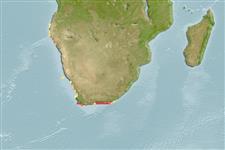>
Blenniiformes (Blennies) >
Clinidae (Clinids)
Etymology: Xenopoclinus: Greek, xenos = strange + Greek, pous = feet + Greek, klinein, kline = sloping and bed, due to the four apophyses of sphenoid bone (Ref. 45335).
Eponymy: H J Koch from Somerset West, South Africa, was a malacologist who collected the holotype with his wife Anne during their field work in conchology. (Ref. 128868), visit book page.
More on author: Smith.
Environment: milieu / climate zone / depth range / distribution range
Ecología
marino demersal; rango de profundidad 0 - 20 m (Ref. 28111). Subtropical
Distribución
Países | Áreas FAO | Ecosistemas | Ocurrencias, apariciones | Point map | Introducciones | Faunafri
Southeast Atlantic: South Africa.
Tamaño / Peso / Age
Maturity: Lm ? range ? - ? cm
Max length : 10.0 cm TL macho / no sexado; (Ref. 5496)
Short description
Claves de identificación | Morfología | Morfometría
Espinas dorsales (total) : 33 - 37; Radios blandos dorsales (total) : 7 - 11; Espinas anales: 2; Radios blandos anales: 29 - 31.
Inhabits intertidal sandy areas near kelp beds. Buries itself in the substrate by diving head first into the sediment and emerging slightly so that the top of the head and the dorsally-situated eyes protrude from the sediment surface. Alternatively, it may lie on the surface of the sediment and use the pectoral, pelvic and anal fins, together with undulatory movements of the body, to insinuate itself into the sediment in a fashion to that of Trachinus vipera. Again, only the top of the head and the eyes are left exposed. Once buried in the sediment, the fish remains there and is able to 'swim' through the sediment for short distances without re-emerging, although it occasionally emerges to undertake short forays (Ref. 28111)
Life cycle and mating behavior
Madurez | Reproducción | Puesta | Huevos | Fecundidad | Larva
Smith, M.M., 1986. Clinidae. p. 758-769. In M.M. Smith and P.C. Heemstra (eds.) Smiths' sea fishes. Springer-Verlag, Berlin. (Ref. 5496)
IUCN Red List Status (Ref. 130435: Version 2024-1)
Threat to humans
Harmless
Human uses
Herramientas
Special reports
Download XML
Fuentes de Internet
Estimates based on models
Preferred temperature (Ref.
123201): 16.3 - 20.9, mean 18.1 °C (based on 47 cells).
Phylogenetic diversity index (Ref.
82804): PD
50 = 0.7500 [Uniqueness, from 0.5 = low to 2.0 = high].
Bayesian length-weight: a=0.00513 (0.00223 - 0.01182), b=3.06 (2.86 - 3.26), in cm total length, based on LWR estimates for this (Sub)family-body shape (Ref.
93245).
Nivel trófico (Ref.
69278): 3.3 ±0.3 se; based on diet studies.
Resiliencia (Ref.
120179): Alto, población duplicada en un tiempo mínimo inferior a 15 meses (Preliminary K or Fecundity.).
Fishing Vulnerability (Ref.
59153): Low vulnerability (10 of 100).
